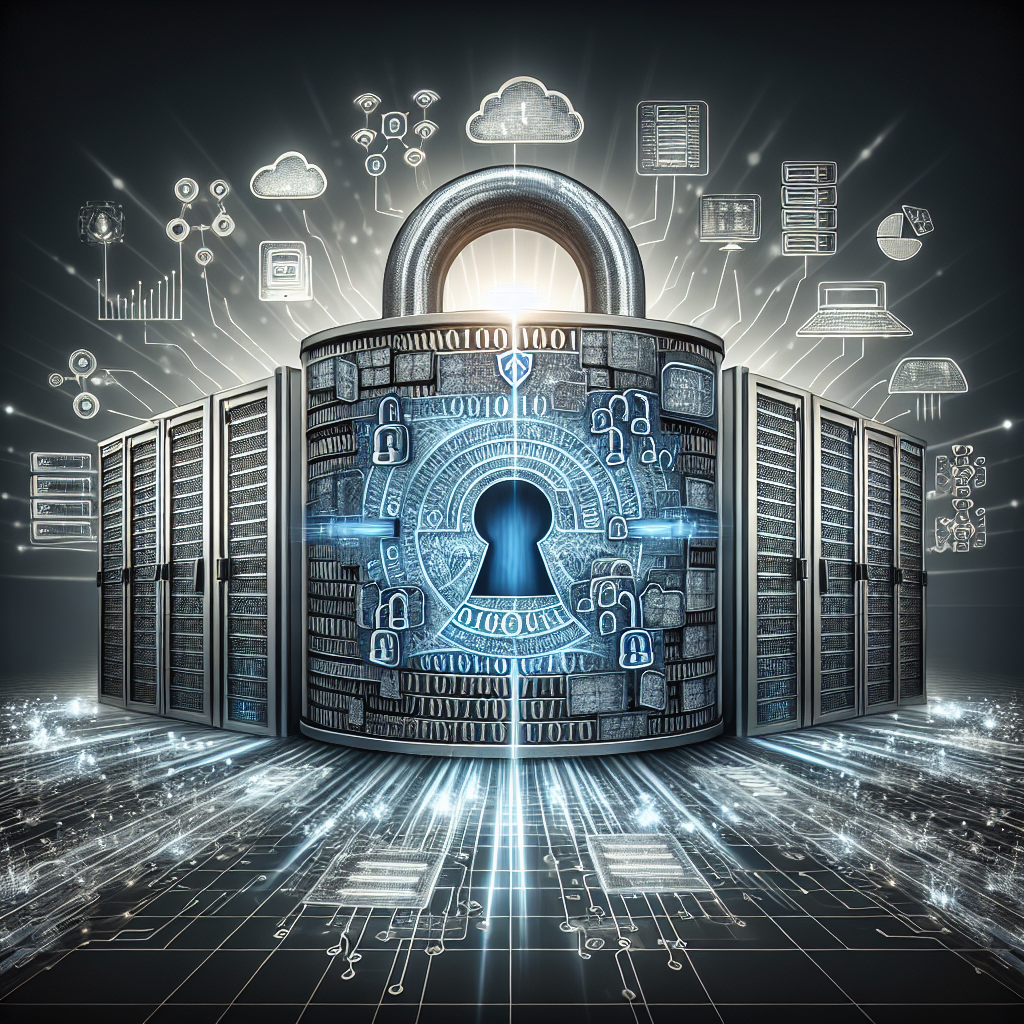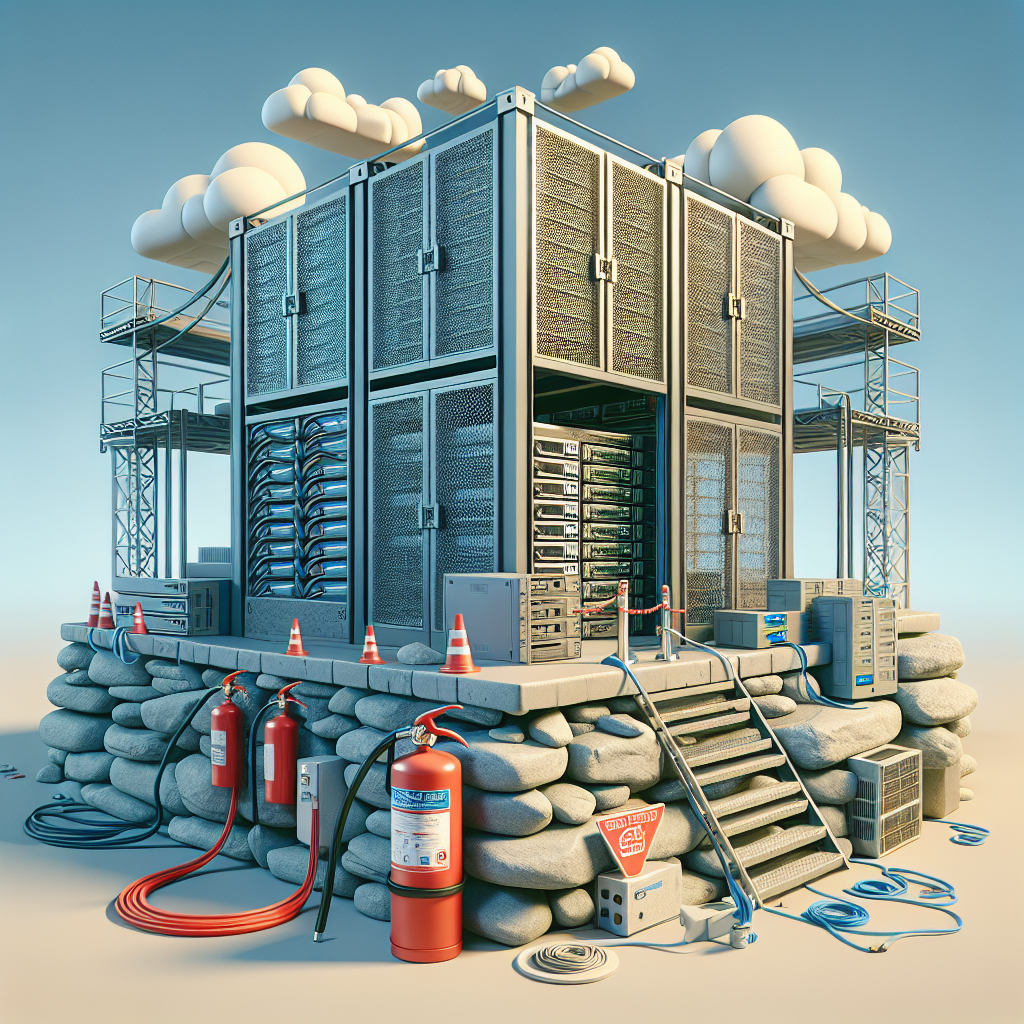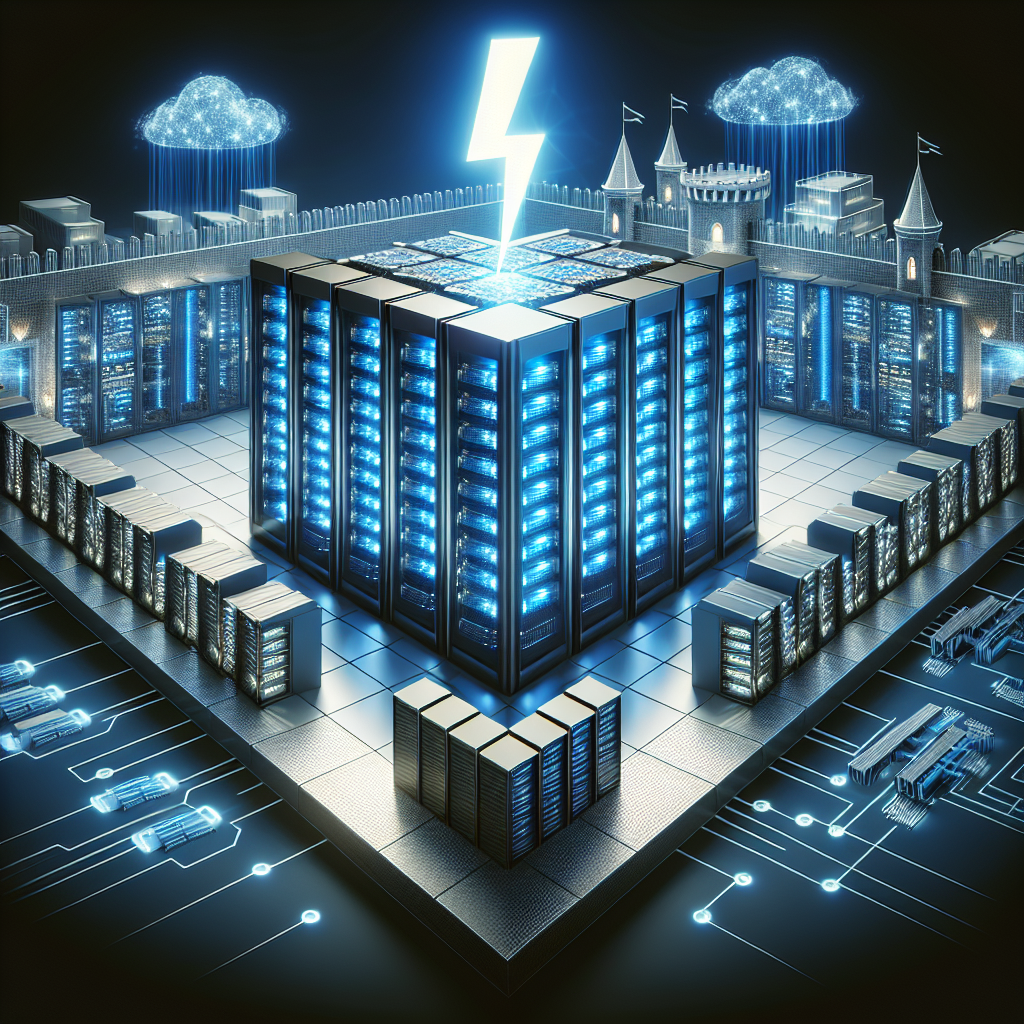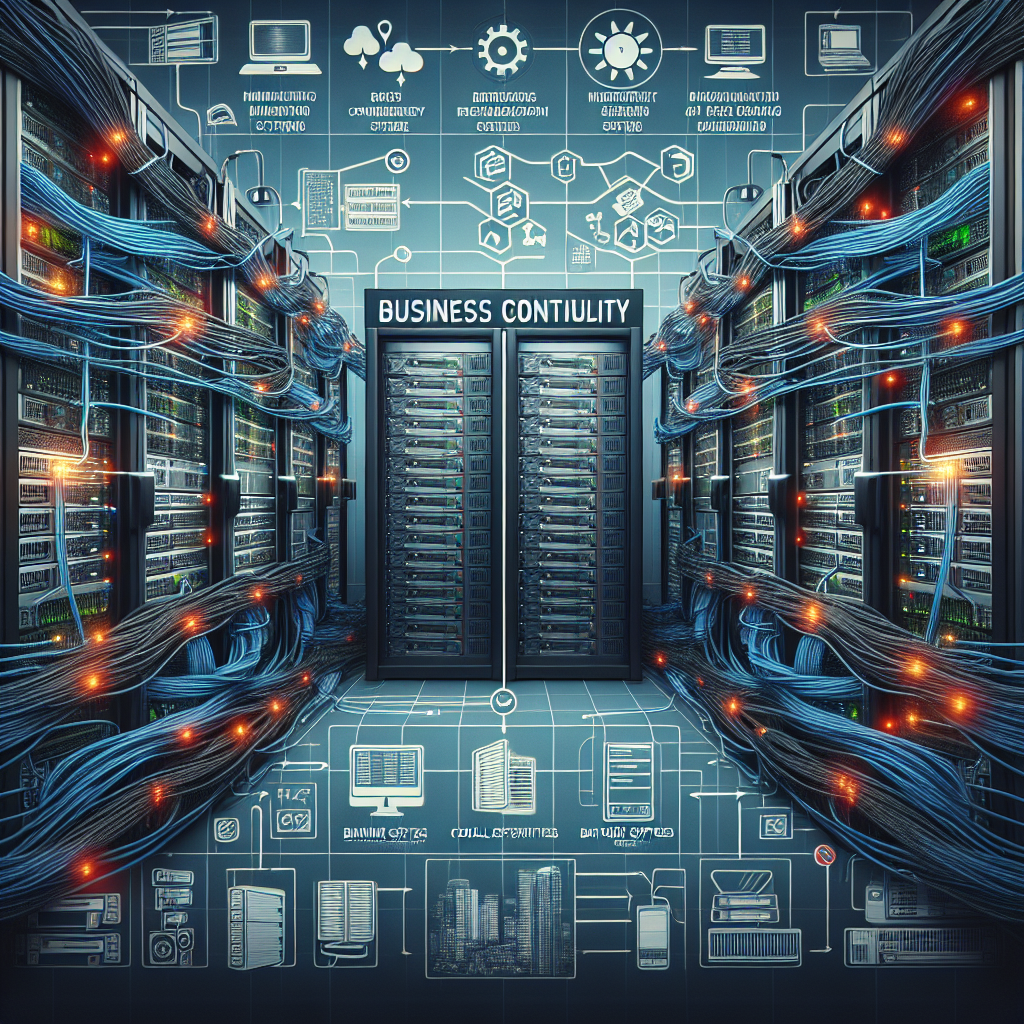Your cart is currently empty!
Tag: Data Center Business Continuity

Safeguarding Your Data Center: Strategies for Ensuring Business Continuity
In today’s digital age, data centers have become the backbone of businesses, storing and processing vast amounts of critical information. With the increasing reliance on technology, safeguarding data centers has become more crucial than ever to ensure business continuity and protect sensitive data from cyber threats.There are several strategies that businesses can implement to safeguard their data centers and minimize the risk of data breaches, downtime, and other disruptions. Here are some key strategies for ensuring business continuity in your data center:
1. Implement a robust security infrastructure: One of the most important steps in safeguarding your data center is to implement a robust security infrastructure. This includes implementing firewalls, intrusion detection systems, access controls, encryption, and other security measures to protect against cyber threats and unauthorized access.
2. Conduct regular security audits and assessments: Regular security audits and assessments are essential to identify vulnerabilities in your data center and address them before they can be exploited by cyber attackers. By conducting regular security audits, you can ensure that your data center is up to date with the latest security standards and best practices.
3. Backup and disaster recovery planning: It is essential to have a comprehensive backup and disaster recovery plan in place to ensure that your data center can quickly recover from any unforeseen events, such as natural disasters, cyber attacks, or hardware failures. Regularly backing up your data and testing your disaster recovery plan can help minimize downtime and data loss in the event of a disaster.
4. Implement redundancy and failover systems: Redundancy and failover systems are essential for ensuring business continuity in your data center. By implementing redundant systems and failover mechanisms, you can ensure that your data center can continue to operate even in the event of a hardware failure or other disruptions.
5. Train your staff on security best practices: Human error is one of the leading causes of data breaches and other security incidents. By training your staff on security best practices, you can help minimize the risk of insider threats and ensure that your data center remains secure.
6. Monitor and analyze security logs: Monitoring and analyzing security logs can help you detect and respond to security incidents in real-time. By monitoring security logs, you can identify unusual activity, unauthorized access attempts, and other potential security threats before they can escalate into a full-blown data breach.
Safeguarding your data center is essential for ensuring business continuity and protecting sensitive data from cyber threats. By implementing robust security measures, conducting regular security audits, and backup and disaster recovery planning, businesses can minimize the risk of data breaches, downtime, and other disruptions in their data center operations. By investing in the right security infrastructure and best practices, businesses can safeguard their data centers and maintain business continuity in today’s digital age.

From Disaster Recovery to Business Continuity: The Evolution of Data Center Strategies
In today’s fast-paced digital world, data centers play a crucial role in ensuring the smooth operation of businesses. From storing important data to hosting critical applications, data centers are the backbone of modern enterprises. However, with the increasing frequency of natural disasters and cyber-attacks, businesses are being forced to rethink their data center strategies to ensure business continuity.Traditionally, data centers have focused on disaster recovery, which involves creating backup copies of data and applications to ensure they can be quickly restored in the event of a disaster. While disaster recovery is essential for minimizing downtime and data loss, it is no longer sufficient to meet the demands of today’s always-on, interconnected world.
Enter business continuity, the next evolution of data center strategies. Business continuity goes beyond simply recovering data and applications after a disaster and focuses on maintaining operations during and after a disruption. This proactive approach involves implementing redundant systems, creating failover mechanisms, and developing comprehensive recovery plans to ensure that business operations can continue uninterrupted in the face of a disaster.
One of the key components of a business continuity strategy is the adoption of cloud computing. Cloud services offer scalability, flexibility, and redundancy, making them an ideal solution for ensuring business continuity. By leveraging cloud services, businesses can replicate their data and applications in multiple locations, ensuring that they can quickly switch to backup systems in the event of a disaster.
Another important aspect of business continuity is the implementation of robust cybersecurity measures. With the increasing frequency and sophistication of cyber-attacks, businesses must take proactive steps to protect their data and applications from malicious actors. This includes implementing firewalls, intrusion detection systems, and encryption protocols to safeguard sensitive information.
In addition to technological solutions, businesses also need to focus on developing comprehensive disaster recovery and business continuity plans. These plans should outline the roles and responsibilities of key personnel, establish communication protocols, and define the steps to be taken in the event of a disaster. Regular testing and updates of these plans are essential to ensure that they remain effective in the face of evolving threats.
In conclusion, the evolution of data center strategies from disaster recovery to business continuity is essential for ensuring the resilience and sustainability of modern businesses. By adopting a proactive approach to data center management, businesses can minimize downtime, protect their valuable assets, and maintain operations in the face of any disruption. Embracing cloud computing, enhancing cybersecurity measures, and developing comprehensive recovery plans are key steps in this evolution, and businesses that prioritize these strategies will be better prepared to navigate the challenges of the digital age.

Building a Strong Foundation: Business Continuity in Data Center Operations
In today’s digital age, data centers play a crucial role in ensuring the smooth functioning of businesses. These facilities house the servers, storage devices, and networking equipment that support the operations of organizations, making them critical to the success of businesses in various industries.One of the key aspects of maintaining a data center is ensuring business continuity in the face of unexpected events or disasters. Building a strong foundation for business continuity in data center operations is essential to minimize downtime, protect valuable data, and maintain the trust of customers and stakeholders.
There are several key elements to consider when developing a robust business continuity plan for data center operations. These include:
1. Risk assessment: Conducting a thorough risk assessment is the first step in identifying potential threats to the data center. This includes natural disasters, cyber-attacks, power outages, hardware failures, and other potential disruptions. By understanding these risks, organizations can develop strategies to mitigate them and minimize their impact on operations.
2. Redundancy and resilience: Building redundancy and resilience into the data center infrastructure is crucial for ensuring business continuity. This includes backup power systems, redundant networking equipment, and redundant data storage solutions. By having redundant systems in place, organizations can minimize the risk of downtime and ensure that critical operations can continue even in the event of a failure.
3. Disaster recovery planning: Developing a comprehensive disaster recovery plan is essential for ensuring that data center operations can be quickly restored in the event of a disaster. This includes having backup copies of data, testing disaster recovery procedures regularly, and having a designated team responsible for executing the plan in case of an emergency.
4. Monitoring and maintenance: Regular monitoring and maintenance of data center equipment are essential for identifying potential issues before they escalate into major disruptions. This includes monitoring power usage, temperature levels, and network performance to ensure that everything is operating optimally. Regular maintenance of equipment can also help prevent hardware failures and extend the lifespan of critical infrastructure.
5. Staff training and awareness: Ensuring that data center staff are properly trained and aware of their roles and responsibilities in the event of an emergency is crucial for effective business continuity. This includes conducting regular training exercises, documenting procedures, and ensuring that staff are familiar with the disaster recovery plan.
By focusing on these key elements, organizations can build a strong foundation for business continuity in data center operations. By investing in redundancy, resilience, disaster recovery planning, monitoring and maintenance, and staff training, organizations can minimize downtime, protect valuable data, and ensure that critical operations can continue even in the face of unexpected events. Building a strong foundation for business continuity in data center operations is essential for the success and resilience of businesses in today’s fast-paced and digital world.

Protecting Your Data Center: A Guide to Business Continuity Management
Data centers are the heart of any organization, housing critical systems and information essential for daily operations. With the increasing dependence on technology, protecting your data center is crucial for ensuring business continuity and minimizing the risk of data loss or downtime. In this guide, we will discuss the importance of business continuity management in safeguarding your data center and provide tips for effectively protecting your organization’s most valuable assets.Why is Business Continuity Management Important for Data Centers?
Business continuity management (BCM) is the process of ensuring that an organization can continue to operate in the event of a disruption, such as a natural disaster, cyber-attack, or equipment failure. For data centers, which store and process vast amounts of critical information, BCM is essential for safeguarding against data loss and downtime that can have severe consequences for a business.
By implementing a robust BCM plan, organizations can identify and mitigate potential risks to their data center, establish protocols for responding to emergencies, and ensure the continuity of operations in times of crisis. This proactive approach not only protects your data center but also helps to maintain customer trust, uphold regulatory compliance, and preserve your organization’s reputation.
Tips for Protecting Your Data Center Through Business Continuity Management
1. Conduct a Risk Assessment: Start by identifying potential risks to your data center, such as natural disasters, cyber-attacks, power outages, and human error. Evaluate the likelihood and impact of each risk to prioritize your BCM efforts.
2. Develop a Business Continuity Plan: Create a comprehensive plan that outlines procedures for responding to different types of disruptions, including data backup and recovery strategies, communication protocols, and alternative workspace arrangements.
3. Test and Update Your Plan Regularly: Conduct regular drills and simulations to test the effectiveness of your BCM plan and identify areas for improvement. Update your plan as necessary to address changing threats and business requirements.
4. Implement Redundant Systems: To minimize the risk of downtime, consider implementing redundant systems and backup solutions for your data center, such as mirrored servers, offsite data storage, and cloud-based services.
5. Secure Your Data Center: Implement robust security measures to protect your data center from physical and cyber threats, including access controls, encryption, firewalls, and intrusion detection systems.
6. Train Your Staff: Ensure that all employees are trained on their roles and responsibilities in the event of a data center disruption. Provide regular training and awareness programs to promote a culture of resilience within your organization.
7. Establish Partnerships: Build relationships with external partners, such as data center providers, vendors, and emergency responders, to enhance your organization’s ability to respond to crises and recover quickly.
By following these tips and implementing a proactive BCM strategy, you can protect your data center and ensure the continuity of your business operations in the face of unexpected disruptions. Remember that investing in business continuity management is an investment in the long-term success and sustainability of your organization.

Data Center Resilience: Maintaining Business Continuity in the Face of Disruptions
In today’s digital age, data centers play a crucial role in supporting businesses of all sizes. These facilities house the servers, storage, and networking equipment that enable organizations to store, process, and access their data. However, data centers are not immune to disruptions, whether they are caused by natural disasters, power outages, equipment failures, or cyberattacks. In order to maintain business continuity in the face of these disruptions, data center resilience is essential.Data center resilience refers to the ability of a facility to continue operating and providing services in the event of a disruption. This requires careful planning, robust infrastructure, and comprehensive strategies for disaster recovery and business continuity. By implementing these measures, organizations can minimize downtime, protect their data, and ensure that their operations remain uninterrupted even in the face of unexpected events.
One key aspect of data center resilience is redundancy. This involves duplicating critical components such as power supplies, cooling systems, and networking equipment to ensure that if one component fails, another can immediately take over. Redundancy can be achieved through the use of backup generators, uninterruptible power supplies (UPS), redundant network connections, and mirrored data storage systems. By having redundant systems in place, data centers can reduce the risk of downtime and ensure that their services remain available to users.
In addition to redundancy, data centers must also have comprehensive disaster recovery plans in place. These plans outline the steps to be taken in the event of a disruption, such as a natural disaster or cyberattack. This includes procedures for backing up data, restoring systems, and communicating with customers and stakeholders. By having a well-defined disaster recovery plan, data centers can minimize the impact of disruptions and quickly recover from any downtime that occurs.
Another critical aspect of data center resilience is security. With the increasing threat of cyberattacks, data centers must have robust security measures in place to protect their systems and data. This includes firewalls, intrusion detection systems, encryption, and access controls to prevent unauthorized access and data breaches. By prioritizing security, data centers can minimize the risk of cyber incidents and ensure the integrity and confidentiality of their data.
Overall, data center resilience is essential for maintaining business continuity in the face of disruptions. By implementing redundancy, disaster recovery plans, and security measures, data centers can minimize downtime, protect their data, and ensure that their services remain available to users. In today’s fast-paced and interconnected world, data center resilience is a critical component of any organization’s IT strategy.

Mitigating Risks: How Data Centers Ensure Business Continuity
In today’s digital age, data centers play a crucial role in ensuring the continuity of business operations. These facilities are responsible for storing, processing, and managing vast amounts of data that businesses rely on to operate efficiently and effectively. However, with the increasing reliance on technology and the growing threat of cyber-attacks, data centers face a number of risks that can disrupt business operations. To mitigate these risks and ensure business continuity, data centers employ a range of strategies and technologies to safeguard their operations.One of the key risks that data centers face is the threat of physical damage, such as fires, floods, or power outages. To mitigate these risks, data centers are designed with redundant systems and backup power supplies to ensure continuous operation in the event of a power outage. Additionally, data centers are equipped with fire suppression systems and other safety measures to protect against physical damage.
Another significant risk that data centers face is the threat of cyber-attacks. As cyber threats continue to evolve and become more sophisticated, data centers must constantly update their security measures to protect against potential breaches. This includes implementing robust security protocols, such as encryption, multi-factor authentication, and intrusion detection systems, to safeguard against unauthorized access to sensitive data.
Data centers also implement strict access controls and monitoring systems to ensure that only authorized personnel have access to critical infrastructure. This helps prevent insider threats and unauthorized access to sensitive data, reducing the risk of data breaches.
In addition to these technical measures, data centers also conduct regular risk assessments and disaster recovery drills to identify potential vulnerabilities and develop contingency plans in the event of a disruption. This proactive approach allows data centers to quickly respond to unforeseen events and minimize the impact on business operations.
Overall, data centers play a critical role in ensuring business continuity by implementing robust security measures, redundant systems, and disaster recovery plans to mitigate risks and protect against potential disruptions. By investing in these measures, businesses can rest assured that their data is safe and secure, and their operations will continue to run smoothly, even in the face of unexpected challenges.

Future Trends and Innovations in Data Center Business Continuity Strategies
Data centers are the backbone of modern businesses, housing the critical infrastructure that supports the digital operations of companies around the world. With the increasing reliance on data and technology, ensuring the continuity of data center operations has become a top priority for organizations. As the landscape of data center business continuity strategies continues to evolve, several future trends and innovations are shaping the way companies approach this crucial aspect of their operations.One of the key trends in data center business continuity strategies is the increasing adoption of cloud-based solutions. Cloud computing offers a flexible and scalable platform for data storage and processing, allowing companies to easily scale their operations and access resources on-demand. By leveraging cloud-based services, organizations can enhance their data center resilience and redundancy, ensuring that critical data and applications are always available, even in the event of a disaster.
Another emerging trend in data center business continuity strategies is the use of artificial intelligence (AI) and machine learning technologies. These advanced technologies can analyze vast amounts of data in real-time, identifying potential risks and vulnerabilities before they escalate into major issues. By leveraging AI and machine learning tools, companies can proactively monitor and manage their data center operations, reducing the risk of downtime and ensuring uninterrupted service delivery to customers.
Additionally, the rise of edge computing is transforming the way companies approach data center business continuity. Edge computing involves processing data closer to the source, reducing latency and improving performance for critical applications. By deploying edge computing infrastructure, organizations can enhance their data center resilience and ensure that data is always available, even in remote or distributed locations.
Furthermore, the integration of automation and orchestration tools is becoming increasingly important in data center business continuity strategies. These tools can streamline the management of data center operations, automating routine tasks and ensuring that resources are allocated efficiently in the event of a disaster. By automating key processes, organizations can improve their response times and minimize the impact of disruptions on their operations.
In conclusion, the future of data center business continuity strategies is bright, with a range of innovative trends and technologies shaping the way companies approach this critical aspect of their operations. From cloud computing and AI to edge computing and automation, organizations have a wealth of tools at their disposal to enhance the resilience and redundancy of their data center operations. By staying ahead of these trends and embracing the latest innovations, companies can ensure that their data center business continuity strategies are robust and effective in the face of evolving threats and challenges.

Navigating Challenges and Building Resilience in Data Center Business Continuity
In today’s digital age, data centers are the backbone of most businesses, housing vital information and ensuring that operations run smoothly. However, with the increasing reliance on technology, data centers are faced with a multitude of challenges that can disrupt business continuity. From natural disasters to cyber attacks, data center managers must be prepared to navigate these obstacles and build resilience to ensure the uninterrupted flow of data.One of the most common challenges facing data centers is the threat of natural disasters. Floods, hurricanes, earthquakes, and wildfires can all pose a significant risk to data center operations, potentially causing downtime and data loss. To mitigate these risks, data center managers must have a comprehensive disaster recovery plan in place. This includes regular testing of backup systems, offsite data storage, and redundant power supplies to ensure that operations can continue in the event of a disaster.
Cyber attacks are another major concern for data centers, with hackers constantly seeking to infiltrate systems and steal sensitive information. To protect against these threats, data center managers must implement robust security measures, such as firewalls, encryption, and multi-factor authentication. Regular security audits and employee training are also essential to ensure that all staff are aware of the risks and know how to respond in the event of a breach.
In addition to external threats, data centers also face internal challenges such as equipment failure and human error. Regular maintenance and monitoring of hardware and software systems are crucial to prevent downtime and ensure the smooth operation of the data center. Staff training and clear communication protocols can also help to minimize the risk of human error and ensure that all employees are equipped to respond effectively in the event of an incident.
Despite these challenges, data center managers can build resilience by adopting a proactive approach to business continuity. This includes regularly reviewing and updating disaster recovery plans, conducting risk assessments, and investing in the latest technology to enhance security and efficiency. Collaboration with industry partners and participation in information-sharing networks can also help data centers stay ahead of emerging threats and adapt to changing circumstances.
In conclusion, navigating challenges and building resilience in data center business continuity requires a proactive and multi-faceted approach. By identifying potential risks, implementing robust security measures, and investing in the latest technology, data center managers can ensure that operations continue uninterrupted even in the face of adversity. With careful planning and preparation, data centers can navigate the complexities of the digital landscape and emerge stronger and more resilient than ever.

Case Studies in Successful Data Center Business Continuity Management
In today’s technology-driven world, data centers play a crucial role in the operations of businesses of all sizes. These facilities house the servers and infrastructure that store, process, and manage the vast amounts of data that companies rely on for their day-to-day operations. With the increasing importance of data centers, ensuring business continuity in the event of a disaster or disruption is essential to the success of any organization.Business continuity management (BCM) is the process of planning for and ensuring the continued operation of critical business functions in the event of a disruption. This includes developing strategies and procedures to minimize downtime, protect data, and ensure the smooth operation of the business during and after a crisis.
Case studies of successful data center business continuity management provide valuable insights into how organizations can effectively plan for and respond to disruptions. By examining these examples, businesses can learn from the experiences of others and improve their own BCM practices.
One such case study is that of a global financial services company that operates multiple data centers around the world. In order to ensure business continuity, the company implemented a comprehensive BCM program that included regular testing and drills, redundant systems, and a detailed communication plan. When a major power outage occurred at one of their data centers, the company was able to quickly switch operations to a backup facility and minimize downtime for their customers.
Another example is a healthcare organization that experienced a cyberattack on their data center. Thanks to their robust BCM program, the organization was able to quickly isolate the affected systems, restore data from backups, and resume operations with minimal disruption to patient care. This incident highlighted the importance of having a comprehensive response plan in place for cyber threats.
In both of these cases, the organizations’ commitment to BCM and their proactive approach to planning and testing paid off when faced with unexpected disruptions. By investing in BCM and continuously reviewing and updating their plans, these companies were able to protect their critical operations and maintain the trust of their customers.
Overall, case studies in successful data center business continuity management demonstrate the importance of preparedness, resilience, and adaptability in the face of disruptions. By learning from these examples and implementing best practices in BCM, organizations can better protect their data and ensure the continued success of their business operations.

The Role of Technology in Enhancing Data Center Business Continuity
In today’s fast-paced digital world, data centers play a crucial role in ensuring the smooth operation of businesses. These facilities house the servers and networking equipment that store and process vast amounts of data, making them essential for the functioning of virtually every industry. However, the increasing reliance on data centers also means that any downtime can have disastrous consequences for a company’s operations. That’s where technology comes in, playing a key role in enhancing data center business continuity.One of the most important ways that technology can improve data center business continuity is through redundancy. Redundancy involves having backup systems in place to ensure that if one component fails, another can seamlessly take its place. This can include redundant power supplies, cooling systems, and networking equipment. By implementing redundancy at every level of the data center infrastructure, businesses can significantly reduce the risk of downtime and ensure that their operations continue to run smoothly even in the event of a failure.
Another important aspect of data center business continuity is disaster recovery planning. Technology plays a crucial role in this area as well, with many data centers now utilizing advanced backup and recovery solutions to ensure that data can be quickly restored in the event of a disaster. This can include regular backups of critical data, as well as the use of technologies such as virtualization to quickly spin up virtual servers in the event of a hardware failure.
In addition to redundancy and disaster recovery planning, technology can also help improve data center business continuity through the use of monitoring and management tools. These tools allow data center operators to keep a close eye on the health and performance of their infrastructure, enabling them to quickly identify and address potential issues before they escalate into full-blown outages. By proactively monitoring their data center environment, businesses can minimize the risk of downtime and ensure that their operations continue to run smoothly.
Overall, technology plays a crucial role in enhancing data center business continuity. By implementing redundancy, disaster recovery planning, and advanced monitoring and management tools, businesses can significantly reduce the risk of downtime and ensure that their operations continue to run smoothly even in the face of unexpected events. As data centers continue to play an increasingly important role in the functioning of businesses, investing in technology to enhance business continuity is essential for ensuring the long-term success and stability of the organization.
